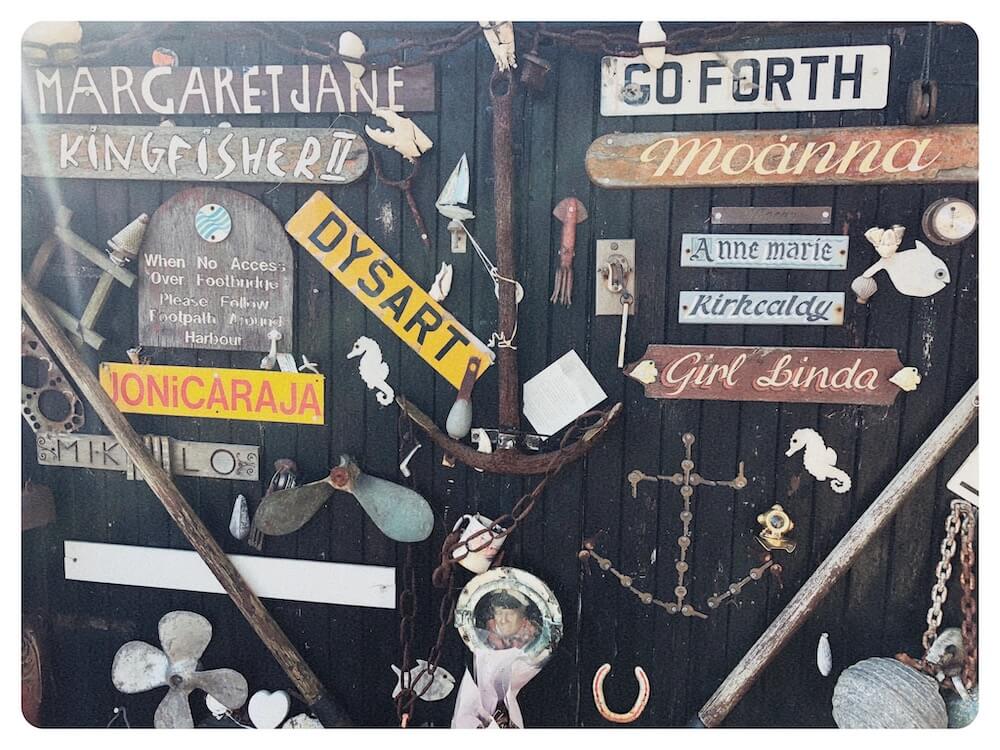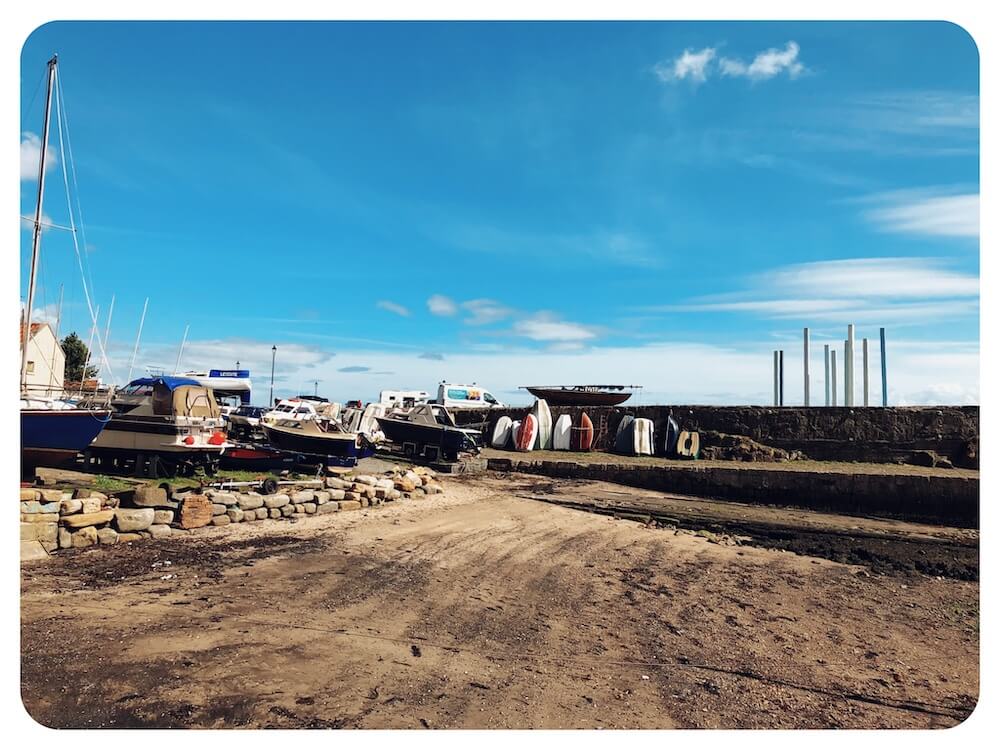How One Wooden Artwork in Dysart Makes Sense of the Sea
This blog is about Scottish Landscape Art, in particular one wooden artwork in Dysart, Fife, by Perthshire artist Donald Urquhart.
In case you haven’t seen it, I’ll share some basic descriptive details and then tell you a bit about how it came to be. I’m writing about it because I love it. Art and culture is how I share Scotland with you.
There’s also a bit of Outsider Art in Dysart too. (On an English immersion holiday we might discuss the hierarchy between these two terms).
As ever, we have an English language challenge for any L2 English users who have discovered this language school blog.
There’s an English language challenge at the end of this post.

Installation shot of Sea Beams, by Donald Urquhart
Fife Coastal Path Artworks
Sea Beams is a sculptural installation by contemporary Scottish artist Donald Urquhart, installed at Dysart Harbour.
In fact, Sea Beams is only one part of an award-winning public art project installed permanently on the Fife Coastal Path.
The sculpture itself is a simple collection of 9 painted beams of wood planted upright into the ground. It’s on the edge of the coast, between the car park, harbour and seafront. Just at the point where charmless, utilitarian infrastructure morphs into a gorgeous, old-world harbour.
The colours of the beams are derived from photographs of the Firth of Forth taken under different light conditions.
These photographs were taken by local residents – a nice link between the community and the site art.

Installation shot of Sea Beams, by Donald Urquhart
A Coastal Landscape of Art
Sea Beams is just one of several artworks placed along this stretch of coast, as part of Dysart Art Project.
Each artwork is united in its remit to not be one more bit of public art plonked into a place, but rather a sensitive frame to view different aspects of the coast with.
Each artwork is a way of looking at or experiencing the coast anew.
Together, the artworks collectively share the story of the coastline both in detail and in panoramic views.
They waymark the journey of those walking through it, as well as commemorating those who have lived – and who continue to live – from it.
Other Artworks
For example, Nest Boxes by Alec Finlay is a series of 12 bird boxes fixed to trees in the arboretum of Ravenscraig Park.
Nest Boxes is a subtle, lovely artwork that no one would ever initially perceive as art, other than in the context of an art trail (which has already opened your eyes to the possibilities of every object along the trail).
Who Left That Bit of Art Lying There?
Sea Beams uses a more traditional, visual language of art than Nest Boxes, but it is certainly not overpowering.
When you first glimpse Urquhart’s sculpture, you sort of wonder if anyone knows that it’s been left there.
Sea Beams echoes the upright masts of boats and the structure of the bridges and even the industry – on the River Forth.
Like an empty flag pole or mast, when you first see it, you assume that it is for something (rather than being art).
Shaped by the Sea
Sea Beams is becoming weathered with cracking paint and splitting wood.
It was built to change. To be changed and shaped by the sea.
Art by Design
The Dysart Art Project was installed in 2007, to celebrate and promote the Fife Coastal Path. That year, it won the Landscape Art Category of the Scottish Design Awards.
The Dysart Art Project was an 18-month-long collaboration between landscape architects, artists, poets, the local authority and the local community.
As a resident of a town that has been half-heartedly considering some kind of sculpture trail within it for over a decade (and without any kind of coordinated plan), I have to add that this is a remarkable, subtle and very intelligent way of putting artworks into a public space.
What Should You Do with a Dead Boat?
Sea Beams is both sea and boat in equal measure.
In my mind, it is a memorial to the painted wooden boat fragments you sometimes discover on beaches.
If you ever find one, you touch the wooden scraps and flaking layers of paint and feel the stories of the sea and of journeys.
You can even sometimes even trace the lettering of the boat’s former name, and say out loud the name of a dead boat.
But then, what do you do with it?
Art Talk
As an artist, I’ve always wanted to rescue such pieces and make something from them.
One time I lugged a large part of the prow of a boat home and made a planter in the garden.
It looked naff. Like something you would find on a roundabout.
These fragments are really powerful when you find them – but personally, I’ve never found the right visual language to commemorate them.
Donald Urquhart has.
Perhaps community members have with their decorated shed doors.

Garage door, Dysart
Vernacular Architecture?
Like many seaside villages and towns, many Dysart residents like to decorate their houses and gardens with beachcombed objects – detritus thrown up by the sea, patinated by the wash of waves and the lives of sea creatures.
In this way, a second tide line creeps up through the town. Most busy at the seafront and lessening on its way through the town.
One resident seems to share my love of old boat names and has decorated their shed with such bits from the sea.
This can be called Outsider Art/Vernacular Architecture.
The garage doors are a fine celebration – a bit like a museum display case.

Installation shot of Sea Beams, by Donald Urquhart
A Contemporary Artwork in the most Tradition-filled Place.
What I love about contemporary art is its ability to speak metaphors.
Unlike the garage doors, Donald Urquhart’s Sea Beams is about every boat: about the ones currently moored patiently in the picturesque harbour – or stacked around it. It references the tall ships which formerly sailed into Dysart Harbour, bringing cargo from The Netherlands, and setting off again with coal, beer, salt and fish.
Sea Beams frames the shoreline, includes the townsfolk and salutes the sea – all without any rhetoric.
It manages to be unsentimental, but it still feels very much a memorial.
As a sculpture, it’s just there if you want a bit of help to appreciate the place you are in.
For all its size, it does not intrude (or obstruct your view of the coast). It especially doesn’t tell you what to think or feel.
Keep it Simple
The public can get annoyed by art that doesn’t look difficult to make. They take it personally (as if it’s trying to trick them).
For me, it’s thrilling when an artist gets something perfectly right in just a few marks, lines or words.
Well done to the whole team of Dysart Art Project for making such simplicity possible.
Such an ambitious land art community art project is anything but simple to do.
Further Information
Find out more about Dysart Art Project.
Read about Donald Urquhart.

Your English Language Challenge
We hope you’ve enjoyed reading about Donald Urquhart’s wooden sculpture in Dysart.
If you are exploring more of Fife, you might like to read:
English Language Immersion Photography Trip to Fife
This week’s English for Creatives Language Challenge is to describe an artwork, design or piece of architecture that you love, that references the sea in some way.
“An artwork that references the sea”


